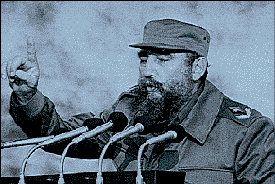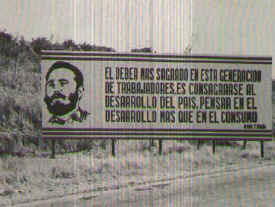|
| |

Part 2: The Transformation of Cuba

Under Fidel Castro's newly acquired rule, a great economic and
social transformation of Cuba took place. His rule was strengthened through the use of the
mass media, the education system, armed forces, and the Socialist Party. Political,
social, and economic life were all affected under Castro's new regime. Immediately, the
system of racial apartheid was abolished. Many supporters of Batista's regime were
arrested or executed. People suspected of antagonism to Castro were arrested. The wealth
of the rich was taken and distributed amongst the people. Many wealthy people fled the
country.
 Castro had all estates and farms larger than a 1000 acres nationalized, or
made the property of the government. All U.S. business and commercial properties in Cuba
were nationalized. An estimated two billion dollars of U.S. property was nationalized.
Land was then split up and given to peasants and agricultural laborers . After this
Agrarian Reform Law, which expropriated Cuba's land, Cuba's relations with the U.S.
deteriorated. The U.S. felt that the law offered inadequate compensation for American
property owners. U.S. president Eisenhower cancelled Cuba's sugar quota; this was the
first commercial sanction by the U.S.. Relations further worsened as Cuba was forced to
pursue a closer alliance with the Communist Block. Castro had all estates and farms larger than a 1000 acres nationalized, or
made the property of the government. All U.S. business and commercial properties in Cuba
were nationalized. An estimated two billion dollars of U.S. property was nationalized.
Land was then split up and given to peasants and agricultural laborers . After this
Agrarian Reform Law, which expropriated Cuba's land, Cuba's relations with the U.S.
deteriorated. The U.S. felt that the law offered inadequate compensation for American
property owners. U.S. president Eisenhower cancelled Cuba's sugar quota; this was the
first commercial sanction by the U.S.. Relations further worsened as Cuba was forced to
pursue a closer alliance with the Communist Block.
A free health care system for all Cuban citizens was built. At
the time it was superior to any in the third world. A free system of education was also
introduced, from primary schools to universities. A huge public works program brought
schools, new roads, hospitals, clinics, and electricity to rural parts of Cuba. Cuba was
well on its way to becoming a socialist country.
 |
A
message to the Cuban people:
"The most sacred duty of this generation
of workers is to consecrate itself
to the development of the country, to think more of
development than of consumption."
-- Fidel Castro
|
Mass media were employed heavily in communicating to and in
shaping the attitudes of the general public. By the middle of 1960, the government had
complete dominance over television and radio facilities. Castro would speak on national
television for hours at a time, lecturing, explaining, convincing the populace. The
newspapers also played a significant role in forming the ideas of the public. Three of the
most important newspapers in the early 1960's were Revolución, Noticias de
Hoy and El Mundo. A quote from Cuba Socialista expresses an
objective of the revolutionary media:
"... the desire of all the revolutionary leaders, beginning
with Fidel Castro, is to transform radio and television into educational instruments
through which the masses may be both informed and formed. Each appearance of the
revolution is always a lesson in economics, politics, history... with a profound Marxist-
Leninist revolutionary meaning...What is sought... is the formation of a new type of
intellectual, of socialist man, a conscious actor in the formidable tasks of his
time." -- José Antonio Portuondo, "Los intelectuales y la Revolución,"
Cuba Socialista.
The education system was also changed to support and strengthen
Castro's government. 1961 became the " Year of Education" with a campaign to
eradicate illiteracy. Over the years the adult literacy rate was raised to 96.1%-- the
highest in Latin America, and among the highest in the world. By 1963, however, only 21%
of the students in the Provincial Party schools had more than a sixth grade education.
Overall, the efficiency of the education system beyond literacy was not considered to be
very great in the early years. Political education was essential to provide the public
with political consciousness and to prepare them for mass organizations or
"mobilization systems," which were federations or associations "for the
accomplishment of revolutionary tasks."
 One major difference in education was that for the
first time, education was distributed equally among rural and urban areas whereas, in the
1930s, 1940s, and 1950s, this type of mobilization was concentrated only in urban areas.
So for the first time in Cuban history, full national political participation became
possible, along with popular susceptibility to the political appeals of the government.
The impact of this drastic change in the education system is quite evident today in Cuba;
the level of social awareness and political activism is very high. One major difference in education was that for the
first time, education was distributed equally among rural and urban areas whereas, in the
1930s, 1940s, and 1950s, this type of mobilization was concentrated only in urban areas.
So for the first time in Cuban history, full national political participation became
possible, along with popular susceptibility to the political appeals of the government.
The impact of this drastic change in the education system is quite evident today in Cuba;
the level of social awareness and political activism is very high.
The revolution of 1959 had results which were far-reaching in
terms of their transformations of Cuban society, the economy, and Cuban-United States
relations. The huge gap between rich and poor was abolished. Conditions for the peasant
majority, blacks, and mulattos were better than ever before. U.S. relations with Cuba
started to rapidly deteriorate, however, when large holding of U.S. businesses were
nationalized by the Cuban government. The U.S. response was to establish an embargo of
Cuban goods. When Cuba turned to the Soviet Union to balance its trade losses, the
relationship between the two countries turned from bad to worse.
Pictures: the commander in chief, Fidel Castro;
billboard in rural Cuba; and Che at the United Nations.


For further information browse these sites:
Bibliography
Geoff Simons, Cuba From Conquistador to
Castro (New York: St. Martin's Press, 1996)
Margot Williams & Josephine McSweeny, Cuba From Columbus To Castro (New York:
Simon & Shuster, 1982)
Richard Fagen, Mass Mobilization in Cuba: The Symbolism of Struggle (Board of
Editors of the Journal of International Affairs, 1966)
Jorge I. Dominguez, Cuba Order and Revolution (Cambridge & London: The
Belknap Press of Harvard University Press, 1978)
The
Cuban Revolution, by Eric Tam
This page was created by the Learning Community team of:
Hazel Frost and Ronald Feichtmeir
|
 One major difference in education was that for the
first time, education was distributed equally among rural and urban areas whereas, in the
1930s, 1940s, and 1950s, this type of mobilization was concentrated only in urban areas.
So for the first time in Cuban history, full national political participation became
possible, along with popular susceptibility to the political appeals of the government.
The impact of this drastic change in the education system is quite evident today in Cuba;
the level of social awareness and political activism is very high.
One major difference in education was that for the
first time, education was distributed equally among rural and urban areas whereas, in the
1930s, 1940s, and 1950s, this type of mobilization was concentrated only in urban areas.
So for the first time in Cuban history, full national political participation became
possible, along with popular susceptibility to the political appeals of the government.
The impact of this drastic change in the education system is quite evident today in Cuba;
the level of social awareness and political activism is very high.![]()